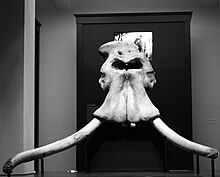| Straight-tusked elephant Temporal range: Mid-Late Pleistocene
~ | |
|---|---|

| |
| Skeleton | |

| |
| Skull in front-on view | |
| Scientific classification | |
| Domain: | Eukaryota |
| Kingdom: | Animalia |
| Phylum: | Chordata |
| Class: | Mammalia |
| Order: | Proboscidea |
| Family: | Elephantidae |
| Genus: | †Palaeoloxodon |
| Species: | †P. antiquus
|
| Binomial name | |
| †Palaeoloxodon antiquus | |

| |
| Approximate range of P. antiquus | |
| Synonyms[2] | |
|
List
| |
The straight-tusked elephant (Palaeoloxodon antiquus) is an extinct species of elephant that inhabited Europe and Western Asia during the Middle and Late Pleistocene. One of the largest known elephant species, mature fully grown bulls on average had a shoulder height of 4 metres (13 ft) and a weight of 13 tonnes (29,000 lb). Straight-tusked elephants likely lived very similarly to modern elephants, with herds of adult females and juveniles and solitary adult males. The species was primarily associated with temperate and Mediterranean woodland and forest habitats, flourishing during interglacial periods, when its range would extend across Europe as far north as Great Britain and Denmark and eastwards into Russia, while persisting in southern Europe during glacial periods. Skeletons found in association with stone tools and wooden spears suggest they were scavenged and hunted by early humans, including Homo heidelbergensis and their Neanderthal successors.
The species is part of the genus Palaeoloxodon (whose other members are also sometimes called straight-tusked elephants), which emerged in Africa during the Early Pleistocene, before dispersing across Eurasia at the beginning of the Middle Pleistocene, with the earliest record of Palaeoloxodon in Europe dated to around 800–700,000 years ago. The straight-tusked elephant is the ancestor of a number of species of dwarf elephants that inhabited islands in the Mediterranean. The species became extinct during the latter half of the Last Glacial Period, with the youngest remains found in the Iberian Peninsula, dating to around 44,000 years ago. Possible even younger records include a single tooth from the Netherlands that has been dated to around 37,000 years ago, and footprints from the southern part of the Iberian peninsula dated to 28,000 years ago.
- ^ Benoit, J., Legendre, L. J., Tabuce, R., Obada, T., Mararescul, V., & Manger, P. (2019). Brain evolution in Proboscidea (Mammalia, Afrotheria) across the Cenozoic. Scientific Reports, 9(1), 9323. https://doi.org/10.1038/s41598-019-45888-4
- ^ Cite error: The named reference
:21was invoked but never defined (see the help page).